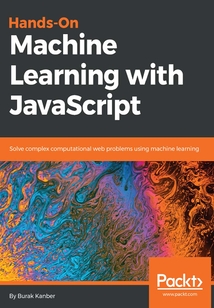舉報(bào) 

會(huì)員
Hands-On Machine Learning with JavaScript
ThisbookisforyouifyouareaJavaScriptdeveloperwhowantstoimplementmachinelearningtomakeapplicationssmarter,gaininsightfulinformationfromthedata,andenterthefieldofmachinelearningwithoutswitchingtoanotherlanguage.WorkingknowledgeofJavaScriptlanguageisexpectedtogetthemostoutofthebook.
目錄(157章)
倒序
- 封面
- 版權(quán)信息
- Packt Upsell
- Why subscribe?
- PacktPub.com
- Contributors
- About the author
- About the reviewer
- Packt is searching for authors like you
- Preface
- Who this book is for
- What this book covers
- To get the most out of this book
- Download the example code files
- Download the color images
- Conventions used
- Get in touch
- Reviews
- Exploring the Potential of JavaScript
- Why JavaScript?
- Why machine learning why now?
- Advantages and challenges of JavaScript
- The CommonJS initiative
- Node.js
- TypeScript language
- Improvements in ES6
- Let and const
- Classes
- Module imports
- Arrow functions
- Object literals
- The for...of function
- Promises
- The async/await functions
- Preparing the development environment
- Installing Node.js
- Optionally installing Yarn
- Creating and initializing an example project
- Creating a Hello World project
- Summary
- Data Exploration
- An overview
- Feature identification
- The curse of dimensionality
- Feature selection and feature extraction
- Pearson correlation example
- Cleaning and preparing data
- Handling missing data
- Missing categorical data
- Missing numerical data
- Handling noise
- Handling outliers
- Transforming and normalizing data
- Summary
- Tour of Machine Learning Algorithms
- Introduction to machine learning
- Types of learning
- Unsupervised learning
- Supervised learning
- Measuring accuracy
- Supervised learning algorithms
- Reinforcement learning
- Categories of algorithms
- Clustering
- Classification
- Regression
- Dimensionality reduction
- Optimization
- Natural language processing
- Image processing
- Summary
- Grouping with Clustering Algorithms
- Average and distance
- Writing the k-means algorithm
- Setting up the environment
- Initializing the algorithm
- Testing random centroid generation
- Assigning points to centroids
- Updating centroid locations
- The main loop
- Example 1 – k-means on simple 2D data
- Example 2 – 3D data
- k-means where k is unknown
- Summary
- Classification Algorithms
- k-Nearest Neighbor
- Building the KNN algorithm
- Example 1 – Height weight and gender
- Example 2 – Decolorizing a photo
- Naive Bayes classifier
- Tokenization
- Building the algorithm
- Example 3 – Movie review sentiment
- Support Vector Machine
- Random forest
- Summary
- Association Rule Algorithms
- The mathematical perspective
- The algorithmic perspective
- Association rule applications
- Example – retail data
- Summary
- Forecasting with Regression Algorithms
- Regression versus classification
- Regression basics
- Example 1 – linear regression
- Example 2 – exponential regression
- Example 3 – polynomial regression
- Other time-series analysis techniques
- Filtering
- Seasonality analysis
- Fourier analysis
- Summary
- Artificial Neural Network Algorithms
- Conceptual overview of neural networks
- Backpropagation training
- Example - XOR in TensorFlow.js
- Summary
- Deep Neural Networks
- Convolutional Neural Networks
- Convolutions and convolution layers
- Example – MNIST handwritten digits
- Recurrent neural networks
- SimpleRNN
- Gated recurrent units
- Long Short-Term Memory
- Summary
- Natural Language Processing in Practice
- String distance
- Term frequency - inverse document frequency
- Tokenizing
- Stemming
- Phonetics
- Part of speech tagging
- Word embedding and neural networks
- Summary
- Using Machine Learning in Real-Time Applications
- Serializing models
- Training models on the server
- Web workers
- Continually improving and per-user models
- Data pipelines
- Data querying
- Data joining and aggregation
- Transformation and normalization
- Storing and delivering data
- Summary
- Choosing the Best Algorithm for Your Application
- Mode of learning
- The task at hand
- Format form input and output
- Available resources
- When it goes wrong
- Combining models
- Summary
- Other Books You May Enjoy
- Leave a review - let other readers know what you think 更新時(shí)間:2021-06-25 21:38:42
推薦閱讀
- Unreal Engine:Game Development from A to Z
- Hands-On Internet of Things with MQTT
- PostgreSQL 11 Server Side Programming Quick Start Guide
- OpenStack for Architects
- 微型計(jì)算機(jī)控制技術(shù)
- 數(shù)據(jù)庫(kù)原理與應(yīng)用技術(shù)學(xué)習(xí)指導(dǎo)
- 快學(xué)Flash動(dòng)畫百例
- Creo Parametric 1.0中文版從入門到精通
- Photoshop CS3圖像處理融會(huì)貫通
- Linux嵌入式系統(tǒng)開發(fā)
- R Machine Learning Projects
- 一步步寫嵌入式操作系統(tǒng)
- Deep Learning Essentials
- Windows 7故障與技巧200例
- 計(jì)算機(jī)硬件技術(shù)基礎(chǔ)學(xué)習(xí)指導(dǎo)與練習(xí)
- 教育創(chuàng)新與創(chuàng)新人才:信息技術(shù)人才培養(yǎng)改革之路(四)
- 軟測(cè)之魂
- 三維動(dòng)畫制作(3ds max7.0)
- Deployment with Docker
- 從0到1 TensorFlow編程手記
- 瘋狂Java實(shí)戰(zhàn)演義
- 關(guān)節(jié)故障空間機(jī)械臂容錯(cuò)運(yùn)動(dòng)控制技術(shù)
- Photoshop CS6兒童數(shù)碼照片處理達(dá)人秘笈
- Hands-On Ensemble Learning with R
- Python Data Analysis
- 物聯(lián)網(wǎng)用傳感器
- Mastering Metasploit
- ABB工業(yè)機(jī)器人進(jìn)階編程與應(yīng)用
- Kali Linux Cookbook
- 機(jī)械識(shí)圖與AutoCAD技術(shù)基礎(chǔ)(2006版)

